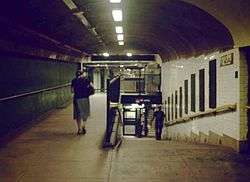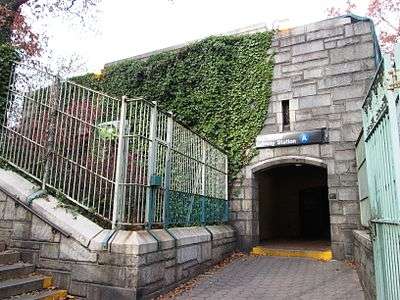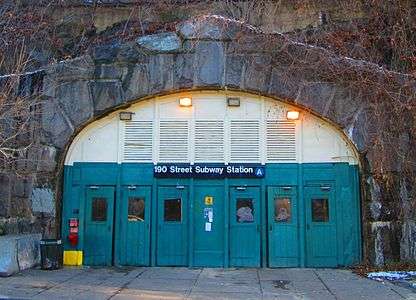190th Street (IND Eighth Avenue Line)
190 Street | |||||||
|---|---|---|---|---|---|---|---|
|
| |||||||
|
Uptown platform | |||||||
| Station statistics | |||||||
| Address |
West 190th Street & Fort Washington Avenue New York, NY 10040 | ||||||
| Borough | Manhattan | ||||||
| Locale | Washington Heights, Hudson Heights | ||||||
| Coordinates | 40°51′32″N 73°56′03″W / 40.858986°N 73.93404°WCoordinates: 40°51′32″N 73°56′03″W / 40.858986°N 73.93404°W | ||||||
| Division | B (IND) | ||||||
| Line | IND Eighth Avenue Line | ||||||
| Services |
A | ||||||
| Transit connections |
| ||||||
| Structure | Underground | ||||||
| Depth | 140 feet (43 m)[1] | ||||||
| Platforms | 2 side platforms | ||||||
| Tracks | 2 | ||||||
| Other information | |||||||
| Opened | September 10, 1932[2] | ||||||
| Station code | 145[3] | ||||||
| Accessible |
| ||||||
| Wireless service |
| ||||||
| Former/other names | 190th Street–Overlook Terrace | ||||||
| Other entrances/ exits | east side of Fort Washington Avenue, west side of Bennett Avenue | ||||||
| Traffic | |||||||
| Passengers (2017) |
1,494,996[5] | ||||||
| Rank | 303 out of 425 | ||||||
| Station succession | |||||||
| Next north |
Dyckman Street: A | ||||||
| Next south |
181st Street: A | ||||||
| |||||||
| |||||||
| |||||||
|
| |||||||
|
190th Street Subway Station (IND) (190th Street-Overlook Terrace Subway Station) | |||||||
 Ft. Washington Ave. entrance building (2014) | |||||||
| MPS | New York City Subway System MPS | ||||||
| NRHP reference # | 05000225[6] | ||||||
| Added to NRHP | March 30, 2005 | ||||||
190th Street (originally 190th Street–Overlook Terrace) is a station on the IND Eighth Avenue Line of the New York City Subway, served by the A train at all times. It is located on Fort Washington Avenue near its intersection with Cabrini Boulevard at Margaret Corbin Circle, about three blocks north of 190th Street.
The station is close to Fort Tryon Park and the Mother Cabrini Shrine in the Hudson Heights neighborhood of Manhattan's Washington Heights area. The Cloisters medieval art museum, a branch of the Metropolitan Museum of Art, is located in the park, about a 10-minute walk north from the station's Fort Washington Avenue exit. An additional exit through the side of the hill leads to Bennett Avenue and provides access to the Broadway Valley area of Washington Heights.
History
Construction for a station at 190th Street began in 1928 by the New York City Board of Transportation as part of a subway expansion. Squire J. Vickers, the chief architect of the Dual System, helped design the 190th Street station. He was responsible for most stations on the IND, and being a painter, he did tile work for the station.[7] Station construction was completed in 1932 along with all the other stations on the line between Inwood–207th Street and Chambers Street–Hudson Terminal, and service began on September 10, 1932. Construction of the whole line cost $191,200,000.[2][8]
On December 28, 1950, the Board of Transportation issued a report concerning the construction of bomb shelters in the subway system. Five deep stations in Washington Heights, including the 190th Street station, were considered to be ideal for being used as bomb-proof shelters. The program was expected to cost $104,000,000. These shelters were expected to provide limited protection against conventional bombs, while providing protection against shock waves and air blast, as well as from the heat and radiation from an atomic bomb. To become suitable as shelters, the stations would require water-supply facilities, first-aid rooms, and additional bathrooms.[9]
In 1951, researchers from New York University concluded that in the case of a nuclear attack, the 190th Street station was sufficiently safe enough to shelter from fallout. This was ascertained after the researchers conducted tests on cosmic rays inside deep subway stations in the area.[10]

On September 5, 1957, the New York City Transit Authority (NYCTA) began allowing free public access to the elevators at the 181st and 190th Street stations. Though the elevators were intended for subway riders, local residents paid the subway fare to avoid climbing about eight stories up Fort Washington Hill. Bills were proposed in the New York State Legislature to put the elevators out of fare control, but these failed in committee. The NYCTA agreed once Joseph Zaretzki, the local State Senator, requested the change.[11]
In 2004, the number of elevator attendants at the station was reduced to one per station as a result of budget cuts by the Metropolitan Transportation Authority (MTA). The agency had intended to remove all the attendants, but kept one in each station after many riders protested. The change saved $1.2 million a year.[12] In November 2007, the MTA proposed savings cuts to help reduce the agency's deficit. As part of the plan, all elevator operators at 190th Street, along with those in four other stations in Washington Heights, would have been cut.[13] On December 7, 2007, the MTA announced that it would not remove the remaining elevator operators at 190th Street, along with those in four other stations in Washington Heights. The move was intended to save $1.7 million a year, but was not implemented due to pushback from elected officials and residents from the area.[14] The elevator attendants currently serve as a way to reassure passengers as the elevators are the primary entrance to the platforms, and passengers often wait for the elevators with an attendant.[15] The attendants at the five stations are primarily maintenance and cleaning workers who suffered injuries that made it hard for them to continue doing their original jobs.[16]
On March 30, 2005, the station was listed on the National Register of Historic Places.[17]
Station layout
| G | Street Level | Exit/Entrance (Bank of elevators in southern exit. Note: Platforms and street level are not accessible) |
| M | Mezzanine | Fare control, station agent, MetroCard vending machines, tunnel to Bennett Avenue |
| P Platform level |
Side platform, doors will open on the right | |
| Northbound | ← | |
| Southbound | → | |
| Side platform, doors will open on the right | ||
The station has two tracks and two side platforms.[18] It is the third-to-last station on the IND Eighth Avenue Line proceeding northbound.[19] The station's platforms are 660 feet (200 m) long, a typical length of station platforms built by the Independent Subway System, and the station itself is 50 feet (15 m) wide.[7] The station has a double-barrel, vaulted ceiling supported by an arcade in the center. Concrete retaining walls also side the station and fit into the structure.[7] The 207th Street-bound platform contains an exit-only (one turnstile and one gate) ramp that bypasses fare control and leads to the passageway to the Bennett Avenue entrance.[20][21] Passengers used to be able to enter the station from the ramp, which is evidenced by tiled mosaics.[22]
Located 140 feet (43 m) below ground level, it is one of the deepest stations in the entire system by distance to ground level; it is even deeper than the 34th Street–Hudson Yards station, the deepest station in the system by elevation below sea level.[1][lower-alpha 1] Despite the fact that this is an extremely deep station, however, the Bennett Avenue entrance is actually at a lower elevation than the platforms, so the ramp slopes down.[24][25] Additionally, Dyckman Street, the next station north, is only one level below the surface, in contrast to the 190th Street station.[26]
The station maintains three elevators from the mezzanine in one tower at its eastern end, and has done so since its opening. There is access from Bennett Avenue via a tunnel.[7] The elevators were formerly only open during the daytime, and required the payment of a fare to use since the fare control for both street entrances to the station was originally located just inside the street doors.[27] Since 1957, the elevators have been available for use by pedestrians going between Bennett Avenue and Fort Washington Avenue without paying a fare; a similar situation exists at 181st Street, the next station downtown,[11] as well as at 191st Street, on the IRT Broadway–Seventh Avenue Line.[28] The elevators to the mezzanine still utilize elevator operators, one of the few stations in the system to do so.[29] The station is not wheelchair accessible (non-ADA-compliant) because access from the fare control area to the platforms is only possible via stairways.[30] There is a staircase available in case of an emergency.[31]
Entrances and exits
Contrary to the station's name, there are no exits to either 190th Street or Overlook Terrace. However, the station has entrances both to Hudson Heights, on top of the ridge, and to the Broadway valley of Washington Heights, on the bottom. The entrance at the top of the ridge is located at the end of Fort Washington Avenue, at Margaret Corbin Circle.[32] The station was built as The Cloisters were under construction, making it possible for the entrance on Fort Washington Avenue to have a stone facade to harmonize it with the entrance to The Cloisters in Fort Tryon Park, which lies directly across Margaret Corbin Circle.[33] There is also an entrance at the west side of Bennett Avenue on the bottom of the ridge, midblock between Broadway and 192nd Street, built right into the rock face. It consists of a passageway to the mezzanine, as well as the elevator banks.[32] Fare control is located in one central location on the lower mezzanine level. The elevators are available for use at no charge for pedestrians going between Hudson Heights on the top and Washington Heights on bottom.[11] Because of stairs at the Ft. Washington Avenue entrance, the pedestrian connection is not handicap accessible.[32]
Gallery
- Fort Washington Avenue entrance
 Stairs to Fort Washington Avenue entrance
Stairs to Fort Washington Avenue entrance Bennett Avenue entrance
Bennett Avenue entrance
Notes
References
- 1 2 Young, Michelle (June 26, 2013). "The Deepest and Highest Subway Stations in NYC: 191st St, 190th Street, Smith & 9th". Untapped Cities. Retrieved April 2, 2018.
- 1 2 "List of the 28 Stations on the New Eighth Ave Line". The New York Times. New York, New York. September 10, 1932. p. 6.
- ↑ "Station Developers' Information". Metropolitan Transportation Authority. Retrieved June 13, 2017.
- ↑ "NYC Subway Wireless – Active Stations". Transit Wireless Wifi. Retrieved May 18, 2016.
- ↑ "Facts and Figures: Annual Subway Ridership 2012–2017". Metropolitan Transportation Authority. July 12, 2018. Retrieved July 12, 2018.
- ↑ "NPS Focus". National Register of Historic Places. National Park Service. Retrieved November 6, 2011.
- 1 2 3 4 Steven Bedford; Stacey Vairo (2004). "NRHP Nomination: 190th Street Subway Station (IND)". National Register of Historic Places. Hartford, Connecticut: National Park Service. Retrieved April 21, 2012.
- ↑ Crowell, Paul (September 10, 1932). "Gay Midnight Crowd Rides First Trains In The New Subway: Throngs at Station an Hour Before Time, Rush Turnstiles When Chains are Dropped" (PDF). New York Times. Retrieved November 8, 2015.
- ↑ Ronan, Thomas P. (December 29, 1950). "Subway Shelters to Cost $104,000,000 Proposed for City – Board Would Build Havens in Present and Proposed Lines or Convert for Defense – Extent of U.S. Aid in Doubt – Most of Routes Would Provide Limited Safety 5 Stations Listed as 'Bomb-Proof'". The New York Times. p. 1. ISSN 0362-4331. Retrieved August 3, 2017.
- ↑ "190th St. Station Held Bomb-Proof – Tests Reveal Eighth Avenue Subway Stop Would Make an Ideal Raid Shelter". The New York Times. December 16, 1951. p. 65. ISSN 0362-4331. Retrieved July 30, 2016.
- 1 2 3 "2 IND Elevators Open to Free Use". The New York Times. September 6, 1957. p. 19. Retrieved July 30, 2016.
- ↑ Piazza, Jo (December 7, 2003). "M.T.A. Urged Not to Cut Elevator Jobs At 5 Stations". The New York Times. ISSN 0362-4331. Retrieved August 3, 2017.
- ↑ Neuman, William (November 30, 2007). "M.T.A. Savings Proposal May Mean Service Cuts". The New York Times. ISSN 0362-4331. Retrieved August 3, 2017.
- ↑ "Changing Course, M.T.A. Will Keep Elevator Operators On". The New York Times. December 8, 2007. ISSN 0362-4331. Retrieved August 3, 2017.
- ↑ Grynbaum, Michael M. (April 28, 2011). "Subway Elevator Operators Dwindle in New York". The New York Times. ISSN 0362-4331. Retrieved August 3, 2017.
- ↑ Waller, Nikki (November 23, 2003). "Neighborhood Report: Washington Heights – City People – Why They Take the A Train (and the 1/9)". The New York Times. ISSN 0362-4331. Retrieved August 3, 2017.
- ↑ "National Register of Historical Places 190th Street Subway Station (IND) (added 2005 - - #05000225)". www.nationalregisterofhistoricplaces.com. Retrieved April 2, 2018.
- ↑ Dougherty, Peter (2006) [2002]. Tracks of the New York City Subway 2006 (3rd ed.). Dougherty. OCLC 49777633 – via Google Books.
- ↑ "A Subway Timetable, Effective June 24, 2018" (PDF). Metropolitan Transportation Authority. Retrieved June 24, 2018.
- ↑ Rosenfeld, Robbie (August 13, 2015). "Uptown ramp". nycsubway.org. Retrieved April 2, 2018.
- ↑ Whitehorne, Wayne (September 24, 1999). "Passageway to Bennett Avenue". nycsubway.org. Retrieved April 2, 2018.
- ↑ David-Paul, David (June 12, 2009). "Downtown sign pointed customers to directly enter 207th Street bound platform without using mezzanine area. Ramp is now exit-only". nycsubway.org. Retrieved April 2, 2018.
- ↑ Flegenheimer, Matt (May 29, 2014). "With New Slant on Subway Elevators, Expect Delays". The New York Times. Retrieved May 29, 2014.
- ↑ Castillo, Wilfredo (December 29, 2012). "Stairs down". nycsubway.org. Retrieved April 2, 2018.
- ↑ Weinberg, Brian (May 14, 2009). "190 St station entrance @ Bennett Ave & W 193 St. Looking west up the tunnel towards the platforms". nycsubway.org. Retrieved April 2, 2018.
- ↑ Cox, Jeremiah (March 7, 2013). "The area behind the high exit turnstiles from the uptown platform (the underpass is how silly passengers wanting to go one stop can enter the station)". subwaynut.com. Retrieved April 2, 2018.
- ↑ "Free Elevators in Subway Fought". The New York Times. August 7, 1939. p. 13. Retrieved July 29, 2016.
- ↑ Kurtz, Josh (August 12, 1991). "Washington Heights Journal; A Subway Passageway Just for the Courageous". The New York Times. ISSN 0362-4331. Retrieved July 30, 2016.
- ↑ Grynbaum, Michael M. (April 28, 2011). "The Subway's Elevator Operators, a Reassuring Amenity of Another Era". The New York Times.
- ↑ "Accessible Stations in the MTA Network". Metropolitan Transportation Authority. Retrieved March 8, 2010.
- ↑ Rosenfeld, Robbie (August 13, 2015). "Emergency Stairs". nycsubway.org. Retrieved April 2, 2018.
- 1 2 3 "MTA Neighborhood Maps: Washington Heights" (PDF). Metropolitan Transportation Authority. 2015. Retrieved July 29, 2016.
- ↑ Husband, Timothy (2013). Creating the Cloisters. Metropolitan Museum of Art. ISBN 9781588394880.
External links
| Wikimedia Commons has media related to 190th Street (IND Eighth Avenue Line). |
- nycsubway.org – IND 8th Avenue: 190th Street/Overlook Terrace
- Station Reporter — A Lefferts
- Station Reporter — A Rockaway
- Fort Washington Avenue entrance from Google Maps Street View
- Bennett Avenue entrance from Google Maps Street View
- Platform from Google Maps Street View





